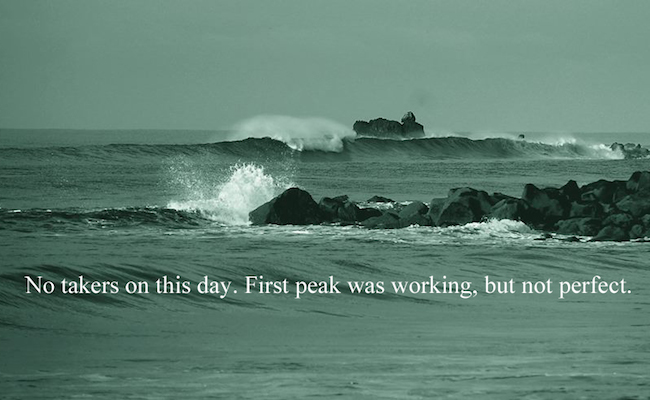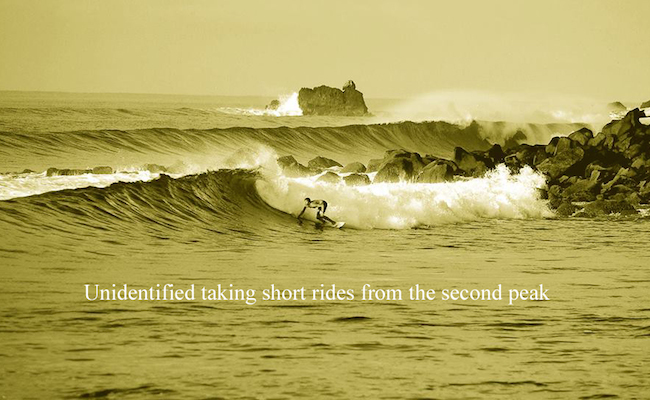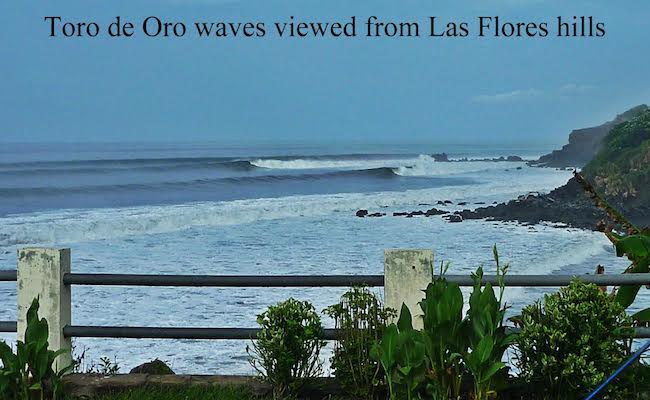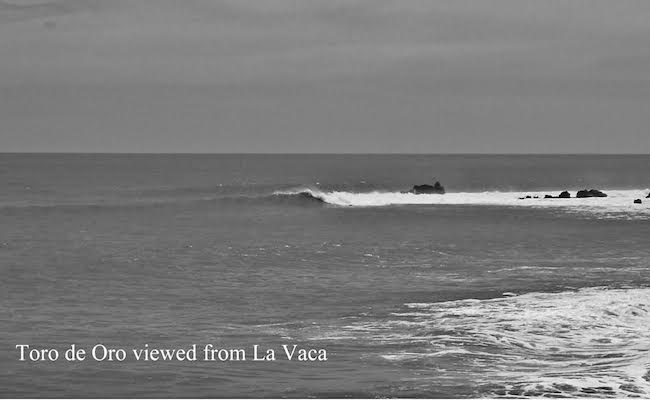Paddle Boarding Toro De Oro, El Salvador
- Written by Staff
- Published in Travel
- Comments::DISQUS_COMMENTS
Words by: Jorge Dominguez
Nowadays, the notion of secret spots for waves does not carry much substance. Surfers take pictures of themselves riding these great waves, and they post them with a caption that they will not reveal the name of the spot because this is a secret spot in this particular country... like they are doing this great favor to humanity. If they wanted to keep the spot secret in a honest way, they would not post any pictures of themselves at all. When you post a picture in the internet, anyone with a little bit of gray matter, Google Earth and GPS technology, will find the exact location of the place in a few hours, if not minutes.
El Salvador is a relatively small country similar in size to Israel. It only has a little bit more than 300 kms of coastline. Nevertheless, when it comes to surfable waves per square km it comes at the top of the pyramid, in the same league as Hawaii and Puerto Rico, if you consider these two places separate regions from the mainland United States. Until recently, El Salvador was perceived as the land of right hand point breaks, but now we know that the country has beach breaks and reefs in every province that has coastline.
Toro de Oro (in English translated as Golden Bull) is not a secret spot contrary to popular opinion. You can find it listed in Magicseaweed.com, one of the main surf forecasting websites in the world. And, I bet most of the surfers that take a boat ride from Las Flores to Punta Mango have seen it from long distance. The first time I surfed Toro de Oro was one day in June 2014 on a 5-6 feet swell. The previous days I had surfed both Las Flores and Punta Mango, in the company of 30 or so surfers, and even though the waves were good I wanted to try something different. On that day I decided to paddle with my SUP from Las Flores to Toro de Oro. I did not have a GPS to measure the exact distance, but it feels like maybe 1.5 km. and Toro de Oro waves can be seen from the hills at Las Flores.

When I arrived with my SUP at Toro de Oro, I was stoked. I thought, if this was Hawaii or California there would be at least 30 surfers hassling for these waves, and I am privileged to have it for myself, with the traditional selfish attitude that most surfers develop. But after I rode my first wave from the first peak, I became scared, and only rode 4 short waves in the next half an hour. It just happens that this month I had broken so many leashes at other spots. In El Salvador it is difficult to find a good thick SUP leash. When you buy longboard leashes for a SUP they do not last long, sometimes they break the very same day you buy them. In mellow spots like El Sunzal, I do not mind very much breaking leashes, looking at it with a positive spin, a broken leash means a good opportunity to practice my swimming skills. But at Toro de Oro, if your leash breaks at the takeoff zone from the first peak, it means the whitewater and the current are going to pull you towards cliffs full of volcanic rock and sharp reef. You are going to emerge cut and bloody. And the ding repair man is going to be happy with a big repair job, if you are able to retrieve your board.
After I chicken out from the first peak, I decided to try the second peak. Here I felt much more comfortable, knowing that if my leash broke, I was not going to end up trapped in the cliffs against the incoming waves. From the second peak, there is a sandy beach to escape to. I had a blast the rest of the day surfing an underrated spot. At the end of my session I began to realize the full potential of this place. I had surfed it at an average, no bigger than 6 feet swell. This spot can handle 15 feet, and if you can connect the 1st peak with the 2nd peak, this is perhaps the longest surfable wave in El Salvador vying for honors with El Sunzal.

Sure, El Sunzal is way more consistent, it breaks on low or high tides every single month of the year. Toro de Oro on the other hand breaks solid only from March till October, has treacherous currents and the tides are tricky. El Sunzal is a fun fat photogenic wave that can handle size, but does not have that much power. In my experience, the lip at El Sunzal is very forgiving, the power of a 10 foott wave at El Sunzal feels like the power of a 5 foot wave at Sunset Beach or Ocean Beach, San Francisco. The lip at Toro de Oro is not soft like El Sunzal; I already felt it at 6 feet, and at 15 feet it is everybody’s guess.
After my first session in June, I have been going to Toro de Oro every month, I feel I am developing an addiction to this place already. Every time I surf it solo, I am expecting someone else to be there, but to this date, solo. At Las Flores and Mango I can get grumpy that there are too many surfers, and at Toro de Oro I wish there were a couple of friends to share the stoke with.
I now realize people have different tastes. Toro de Oro is not really a barreling wave like Punta Mango or Punta Roca. For shortboards, Toro de Oro is probably too much work for too little gain. If a shortboarder does not want to pay for a boat ride to take him to Toro de Oro, he has to arm paddle from Las Flores for who knows, maybe 1.5 km. And when you finally get there, if you start riding waves for long distances, the arm paddle can get brutal, but can be done, believe me. It is about choices. Do you want to be in a world class barreling wave with easy arm paddles but with a big crowd? Or, do you want to be in an uncrowded spot where most of the time is going to be spent arm paddling back to reach the take off zone instead of catching waves every 5 minutes? For the shortboarders that would rather pay a boat ride, money cannot guarantee security. If the leash fails, they are stuck in the same predicament as I am, they are going to end up smashed against the cliffs. A panga or motorized boat cannot rescue you there.

As I said before, Toro de Oro can handle 15 feet without closing out. And at this size there is no need for tow-in. Toro de Oro, being a right hand point break will give the advantage to SUPs over other surfboards, whether you like it or not. This will become evident when trying to beat the strong currents and returning to the take off zone after a long ride. However, beating the shore-break is not comfortable at this size for a SUP; you don’t have the luxury of duck diving like a shortboard. It requires a lot of strength to force the SUP through the pounding waves. Maybe the solution to beat the shore-break and to provide security in case your leash breaks lies in a jet-ski for rescue operations. But, I would not recommend at all tow-in at this place. If guys are already arm paddling at 30 foot waves in Peahi, it will look lame to tow-in at 15 feet Toro de Oro.
Stand Up Paddling is ideal for Toro de Oro not only because it can handle big waves in the winter, but it can also handle the little family waves of the summer. From November - February, waves become super small in the East coast of El Salvador, 1 - 3 feet, which makes them too soft, fat and unappealing for shortboards and longboards. For SUP, this is the perfect time to learn and play with waves. Currently, due to the small size of the waves in the summer, many hotels in the East coast close full time, and the ones that remain open, they only do it part time.
One of the most obvious questions people ask me is regarding access by land. The answer is yes, but it is not for couch potatoes that are expecting dinner to be ready without moving a finger. There is a dirt road from Las Flores to Punta Mango that runs for about 11 kms, and Toro de Oro is just about 1.5 km from Las Flores and about 3.5 km from El Cuco, the main town in the area. Once you arrive at Hacienda Toro de Oro, you need to ask for permission to enter. From the gate to the water it is about half a km, and can only be done by walking or on a horse. The surf spot is technically a public beach but lies on private property. Toro de Oro surf spot is located on a 688 acres hacienda going by the same name.

This magnificent hacienda is still not developed, if by development people understand hotels to accommodate surfers. There is no such thing as that yet, but it’s a place that feels at once exotic and familiar. It is not a jungle, it is an hacienda that has quality livestock like fine horses and bulls. When I carried my SUP board on the horse, I day dreamed that this would be the preferred means of transportation inside the hacienda in the future if the owners decide to develop if for surfing.

Staff
Submit your news, events, and all SUP info, so we can keep promoting and driving the great lifestyle of stand up paddling, building its community, and introducing people to healthier living.
Website: supconnect.com Email This email address is being protected from spambots. You need JavaScript enabled to view it.





